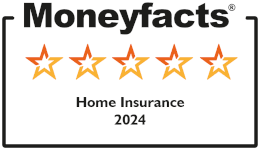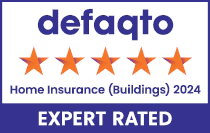Home Insurance Terms Explained
Home insurance terminology can be confusing. And it can be stressful trying to navigate the different policies, add-ons and features needed to protect your home and belongings.
That’s why the experts at Homeprotect have compiled a list of the most commonly misunderstood home insurance terms, along with simple explanations.
Use our glossary below to learn all about the different types of home insurance and related terminology:

Insurance products
Buildings insurance – buildings insurance covers policyholders against the cost of repairing or rebuilding the structure of their property if it’s damaged by fire, storms, malicious damage and more. These policies, subject to terms and conditions, typically also protect against the cost of repairing additional features, such as interior decorations, fixtures and fittings, gates and walls and garages and outbuildings.
Contents insurance – contents insurance protects policyholders against the cost of repairing or replacing items inside the home – such as furniture and electronics – if they’re damaged by fire, flooding, burglary, malicious damage and more. It may also provide cover outside the home, for example for contents that are in your garden or outbuildings.
Personal possessions cover – personal possessions cover is typically offered as a policy add-on for contents insurance. It extends contents cover to your belongings when they are taken out of the home. For example, if your possessions are damaged or stolen while you’re out and about, personal possessions insurance may cover the cost of repair or replacement.
Accidental damage cover – accidental damage insurance is a popular policy add-on to buildings and contents insurance. It is designed to protect homes and their contents against unintended or unexpected events, caused by the policyholder, guests or a third party that cause sudden damage requiring a repair or replacement. This may include fixing a broken window caused by a rogue football, or replacing a dropped phone that won’t turn on.
Home emergency insurance – home emergency cover is designed to protect policyholders against the cost of emergency callouts to temporarily repair home fixtures and appliances, such as boilers, pipes, electrics, windows and doors. It is designed to provide a quick fix in home emergencies to avoid costly damage, and typically covers callouts for tradespeople such as locksmiths, electricians and plumbers.
Non-standard home insurance – non-standard home insurance is a specialist type of buildings insurance. It will usually cover homes made with materials other than traditional bricks, slate and tile. This may include eco homes, those built with timber or steel frames, concrete buildings and more – which many home insurance providers may refuse to insure. Non-standard home insurance may also cover properties which may struggle to secure policies with traditional providers, such as homes with a history of flooding, unoccupied houses and holiday homes. Providers like Homeprotect offer buildings cover for many non-standard property types.
Unoccupied property insurance – an ‘unoccupied property’ is a term used by insurance providers to refer to homes that are left empty for an extended period (typically more than 30-60 days). Homeowners are expected to tell their insurance provider if their property will be left unoccupied, as they may need to adjust their policy terms to reflect the increased risks facing an empty home. Some specialist insurance providers offer unoccupied home insurance designed to cover homes that are left empty long-term – this tends to be cheaper however it typically come with cover restrictions, such as limiting claims to fire.
Holiday home insurance – holiday home insurance is a specialist buildings and contents insurance policy designed to protect second homes – typically used for family holidays and getaways and potentially even properties that are rented out, for example, through Airbnb. Policy terms are designed to reflect the increased risks facing properties that are left empty for extended periods.
Second home insurance – second home insurance is a specialist buildings and contents insurance policy designed to protect properties used as non-permanent residencies – for example, homes lived in on weekends or weekdays only, holiday homes and even rental properties. It is designed to protect against the unique risks or use cases of the property, such as being left unoccupied for long periods.
Listed buildings insurance – listed buildings are properties deemed to have historical, architectural or cultural significance that is legally protected and regulated. For this reason, many insurance providers won’t offer standard home insurance policies for listed buildings, due to the potentially significant costs of repairs or replacements if the worst happens. Listed buildings insurance is therefore a specialist policy offered by certain providers, like Homeprotect, providing building and contents insurance for these unique properties.
Landlord insurance – landlord insurance is a specialist buildings and contents insurance policy tailored to reflect the unique circumstances and risks facing landlords renting to tenants – including both live-in and live-out landlords.
Renters insurance – renters insurance – also known as tenants insurance – is a contents insurance policy specifically designed for people who rent their home. While landlords have a responsibility to protect the property with buildings insurance, the tenants’ belongings won’t be covered under any of their landlord’s policies. Tenants insurance, therefore, protects renters against the cost of repairing or replacing their belongings if they’re damaged by flood, fire, robbery and more.
Subsidence insurance – Subsidence is the sinking of a building’s foundations caused by downward movement in the ground. However, many insurance providers will refuse to insure homes with a history of subsidence due to the increased risk of damage – so, homeowners might need a specialist subsidence insurance policy that accounts for the unique circumstances of the building.
Renovation insurance – Renovations insurance is a term used to describe a home insurance policy taken out when renovating. Home renovations – from loft conversions to smaller DIY projects – come with potential risks, whether due to tools left lying around, contractors in the home and more. Because of this, many home insurance providers will void policies while renovations take place – leaving homeowners completely unprotected during these periods. Renovations insurance is a specialist policy designed to provide buildings and contents insurance for the areas of the home that aren’t being renovated, while the contractor’s insurance covers the areas being worked on.
Home business insurance – home business insurance is a name commonly given to home insurance policies taken out while running a home business. It is popular, as working from home – whether as a childminder, counsellor or any other type of home-based entrepreneur – can pose additional risks to home insurance providers in costly business equipment, regular workplace visitors and more. Specialist home business insurance is designed to provide buildings and contents cover to those working from home who may have been refused by standard providers.
Flood risk/flood cover – some homes in areas at high risk of flooding may be refused home insurance by standard providers due to the increased possibility of water damage. Flood risk cover is a specialist home insurance policy designed to protect those in areas of possible flooding, reflecting the additional risk posed to the provider. These policies typically come with higher premiums and excesses but provide much-needed peace of mind.
Additional home insurance jargon
Excess – an excess is a sum of money that a home insurance policyholder agrees to pay out of their own pocket when making a claim – with the policy provider covering the additional amount paid out. Typically, the higher the agreed excess, the lower the monthly premiums. A standard excess typically applies and a policyholder can supplement this with an additional voluntary excess, as a way to reduce their premium.
Sums insured – This is the maximum amount of money you could receive in the event of an incident (the incident is called an Insured Loss).
Underinsured – the term ‘underinsured’ refers to a situation in which someone’s home insurance policy doesn’t cover the full repair or rebuild costs if the worst happens. In this case, the homeowner would likely have any claim settlement reduced by the proportion they are underinsured by. It’s important to consider whether the sums insured are adequate for the buildings and/or contents, to protect against the risk of underinsurance.
Claim – a claim is a formal request made to a home insurance provider to pay for repairs or replacements after building or contents damage that meets the criteria outlined in a policy. A successful claim meets the terms of the policy and is approved and paid out by the provider.
Premiums – premiums refer to the monthly payments made to a home insurance provider to maintain the policy. These are calculated based on the perceived risk to the provider, with higher value properties and contents – and a higher perceived risk of damage – meaning higher monthly premiums.
No claims discount – some home insurance providers offer a ‘no claims discount’ to policyholders – reducing their monthly premiums if they can prove they have gone an extended period without claiming on their policy. This is because they are deemed to be at lower risk due to their claim history.
Pet damage – many home insurers will exclude damage caused by pets from their policies, due to the increased perceived risk and difficulty calculating premiums for different animals. So, it’s important to check your accidental damage policy to see if it covers pet damage.
Endorsement – an endorsement – sometimes referred to as an ‘addendum’ – is a term, condition, limitation or extension of cover that applies to an active home insurance policy. An endorsement must be negotiated with the insurance provider, who will adjust the policy accordingly. Endorsements may include restricting the terms of the cover – for example, for an unoccupied property – extending the terms or simply adding more detail and clarity over the policy.
Peril – perils – sometimes referred to as ‘insured loss’ – are the events, incidents or actions that can cause property or content damage or loss such as fire, storm, flood, escape of water, theft, malicious damage, subsidence, landslip or heave.
Escape of water – escape of water refers to the leaking of water into a home from pipes, water tanks, boilers or other kitchen appliances. It is a peril that can damage homes and contents, such as furniture, electrics and carpeting, by way of damp and residue.
Water ingress – water ingress is the intrusion of water – typically rainwater – into the home from an outside source. It can damage buildings and contents and may even make homes uninhabitable until the damage is fixed.
Inception – an ‘inception’ date is the exact day and time at which a home insurance policy becomes active. Homes and contents will not be covered until the inception of the policy and any damage or loss that occurred before the inception date will not be valid for a claim after the policy becomes active.
Loss adjustor – a loss adjustor is the insurance professional responsible for assessing a property to judge whether the extent of damage or loss meets the terms of the policy claim. They are appointed by the home insurance provider and are ultimately responsible for approving or rejecting a home insurance claim.
We hope you found this glossary useful – and that you now feel confident in the type of policy and potential add-ons you need to protect your home and its contents.
Ready to get insured? Here’s why you should choose Homeprotect:
Why Choose Us
Policies underwritten by AXA Insurance
AXA underwrites Homeprotect insurance policies
72% saved money when they switched to Homeprotect
Based on survey data of 1,635 buying customers*
Buildings insurance rated 5 star by Defaqto
Defaqto helps people make smarter financial decisions
Basic Legal Expenses and Home Emergency included
Upgrade for full home emergency or legal expenses cover

Get a home insurance quote online
Get a quote online in less than 10 minutes*



